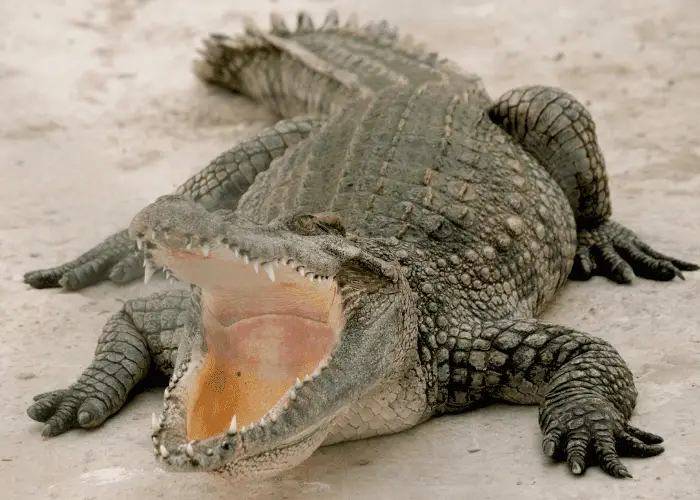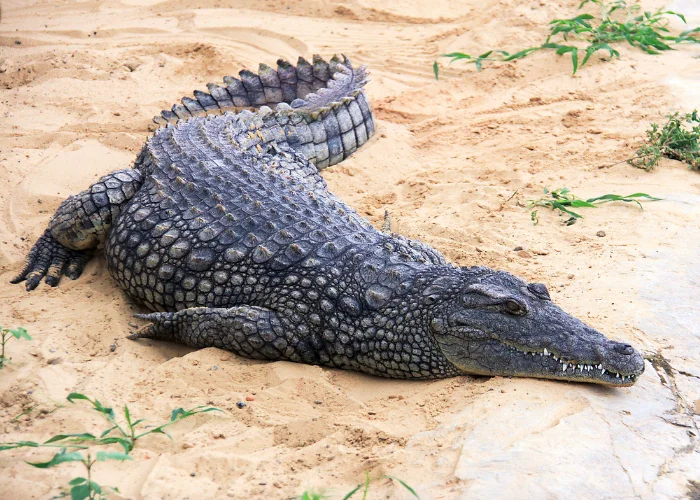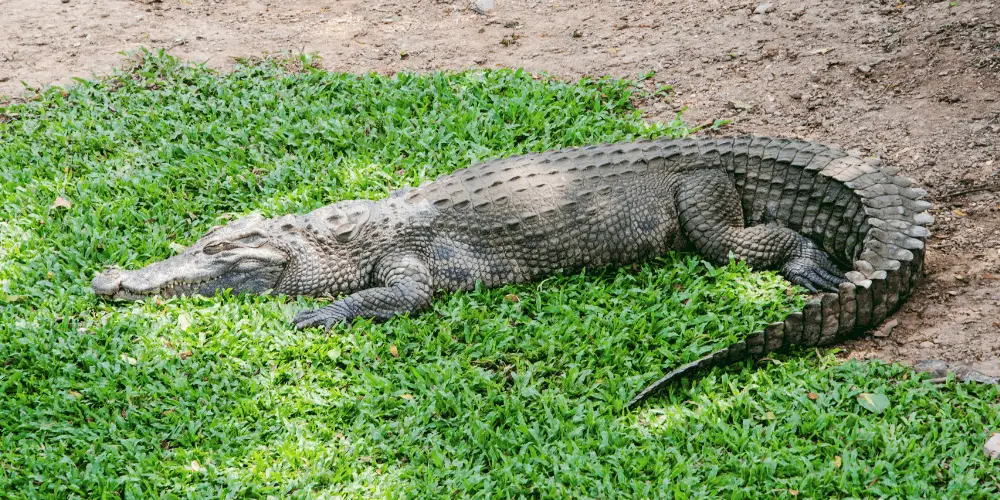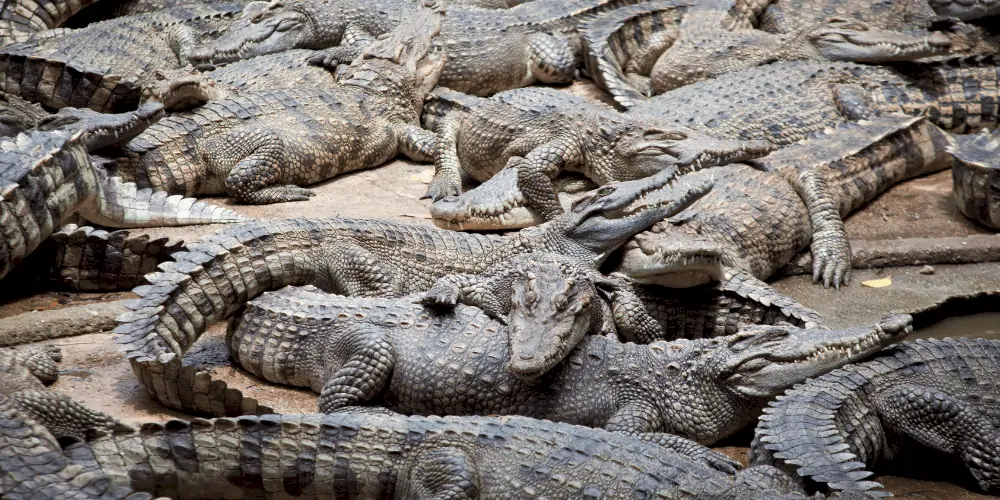Crocodiles may not seem like the fastest animals on land, right? However, many crocs can move surprisingly fast over land, often surprising or outrunning their prey when they decide to run.
It’s strange because, with such short little legs, you’d think they’d be pretty slow! You may be wondering, how fast can a crocodile run?
Crocodiles, on average, can achieve speeds of up to 12-14 kph for short periods on land when they “belly run” or move in a snake-like fashion. The fastest-ever recorded running speed is 17 mph, measured in a galloping Australian freshwater crocodile.
So, how can a creature with such short little legs move this fast on land? Let’s get to the bottom of this by taking a closer look at the anatomy of the crocodile.
Keep reading to learn everything you need about how fast crocodiles can run.
How Crocodiles Can Run on Land

As we stated earlier, many crocodiles can run between 6 to 7 mph speeds. This is pretty fast. However, they can only maintain these speeds for a few body lengths. Their bodies are designed to sustain short bursts of speed, but will not be able to maintain that speed for much longer than a second or two.
Most crocodiles can achieve speeds of around 12 to 14 kph (7.46-8.70 mph) for short periods, which is somewhat slower than a fit human can run. Don’t believe the hype – if you’re reasonably fit, you can definitely outrun a crocodile! Even faster are galloping crocodiles, and Australian freshwater crocodiles have been clocked at just over 17 kph (10.56 mph) over distances of perhaps 20 to 30 metres before they begin to tire
– crocodilian.com
So, since most humans can run at speeds between 10 to 15 mph, you shouldn’t have to worry about getting run down by a croc.
If you’re more than two or three crocodile body lengths away, the croc won’t be able to get you. You may want to watch out if you’re closer than that.
But why do crocs run this way?
Crocodiles are built for hunting in the water primarily and have not evolved legs strong enough to carry them over the land for long periods.
As such, they can use their strength to propel themselves forward a couple of body lengths on land, but after that, they’ll be too tuckered out to do anything else.
This is also due in part to the length of their legs. Yes, they have four legs, which helps. But they’re all stubby and short, unable to cover much distance at once. Their bodies have evolved to suit a particular hunting style best.
Crocodile Locomotion/Gait types

But what about a crocodile’s various gaits? Crocs have 3 gaits or modes of moving over land. These include:
- Belly Crawl: The belly crawl is the slowest of the croc’s gaits, pushing itself over land using its legs. Its belly will drag over the ground, which is not a gait used for hunting.
- High Walk: This gait is used to help the croc clear ground obstacles, like rocks and branches. However, it takes a lot of energy to keep their large bodies up and off the ground.
- Gallop: This is similar to the gallop of a horse. Crocs use this gait to run, bringing their two front legs up together, then their two back legs. They will appear bounding when doing this but may look a bit awkward due to their body proportions. Galloping is usually used to escape danger.
These three modes of crocodilian locomotion are usually used for movement only and not for hunting. Galloping is the only of the three that may be used for hunting, but even then, it is more often used to escape danger or rush something threatening it.
How Crocodiles Hunt

Crocodiles hunt by ambushing their prey. They are not built for long drawn-out pursuits, but short bursts of speed intended to catch their prey unawares. Crocodiles will launch surprise attacks from the water most of the time, hardly ever needing to hunt on land.
If you can see a crocodile, you already have the upper hand. The chances of them leaping out of the water to chase you or any animal over land are extremely low. Of course, crocodiles hunt humans only from the water’s edge.
Be careful whenever you could be around a group of crocodiles, as they are expert ambushers who blend in with their surroundings.
If you know you’re in crocodile territory, try to stay away from riverbanks or other areas of water that are hidden or obscured by weeds and bushes. Crocodiles will use these areas as primary ambush points.
Final Thoughts

While it’s true that most crocodile species can move quickly on land, the chances of them hunting you or another land animal in this way are pretty slim. Crocodiles will usually run to escape danger and not to hunt prey.
We hope the information we’ve outlined above has answered all your questions about how fast crocodiles can run.
For more information on animals, check out our other articles!
- Can Alligators and Crocodiles Climb Trees?
- Can Crocodiles Regrow Limbs?
- How Long Can a Crocodile Go Without Eating?
- Can Crocodiles Feel Pain?
- What is a Group of Crocodiles Called?
Related Questions
1. Can You Outrun a Crocodile?
Most crocodiles can achieve 6-7mph for short periods, which is slower than the maximum speed of 20 mph a fit human can run. So if you’re in good shape, you could outrun a crocodile.”
2. How Fast Can a Crocodile Swim?
Even though crocodiles can move pretty fast on land, they are much more suited for swimming. Most crocodiles can swim up to 18 mph and sustain this speed for long periods. They may be able to swim even faster when escaping danger or chasing prey.
Depending on the species, some may swim faster or slower. Let’s look at the swimming speeds of the 4 most well-known species.
- Nile Crocodile: Run between speeds of 19 to 22 mph.
- American Crocodile: Run between speeds of 19 to 20 mph.
- Saltwater Crocodile: Run between speeds of 15 to 18 mph.
- Dwarf Crocodile: Run at speeds of up to 11 mph.
As you can see, the running speeds of different species will vary. Some may swim much faster than others.
The numbers above show that they are extremely dangerous in the water. While you should be able to outrun a croc on land, you would never be able to outrun one in the water. If you ever find yourself in the water with a croc, get back on land fast!
REFERENCES:
Hutchinson, J. R., Felkler, D., Houston, K., Chang, Y.-M., Brueggen, J., Kledzik, D., & Vliet, K. A. (2019, December 17). Divergent evolution of terrestrial locomotor abilities in extant Crocodylia. Nature News. Retrieved January 23, 2023, from https://www.nature.com/articles/s41598-019-55768-6



